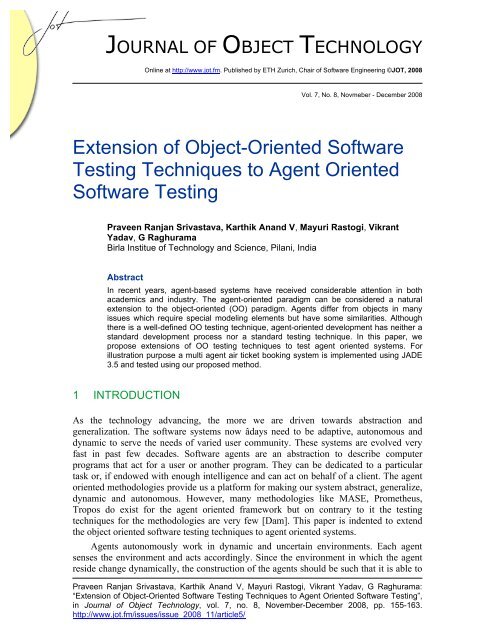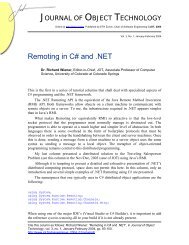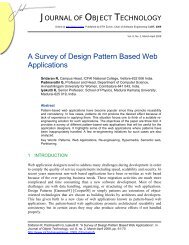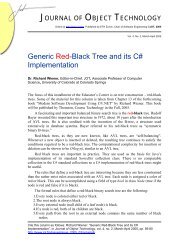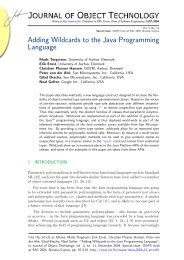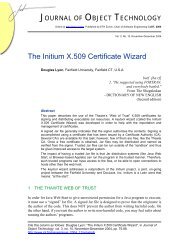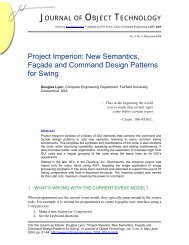Extension of Object-Oriented Software Testing Techniques to Agent ...
Extension of Object-Oriented Software Testing Techniques to Agent ...
Extension of Object-Oriented Software Testing Techniques to Agent ...
You also want an ePaper? Increase the reach of your titles
YUMPU automatically turns print PDFs into web optimized ePapers that Google loves.
JOURNAL OF OBJECT TECHNOLOGYOnline at http://www.jot.fm. Published by ETH Zurich, Chair <strong>of</strong> S<strong>of</strong>tware Engineering ©JOT, 2008Vol. 7, No. 8, Novmeber - December 2008<strong>Extension</strong> <strong>of</strong> <strong>Object</strong>-<strong>Oriented</strong> S<strong>of</strong>tware<strong>Testing</strong> <strong>Techniques</strong> <strong>to</strong> <strong>Agent</strong> <strong>Oriented</strong>S<strong>of</strong>tware <strong>Testing</strong>Praveen Ranjan Srivastava, Karthik Anand V, Mayuri Ras<strong>to</strong>gi, VikrantYadav, G RaghuramaBirla Institue <strong>of</strong> Technology and Science, Pilani, IndiaAbstractIn recent years, agent-based systems have received considerable attention in bothacademics and industry. The agent-oriented paradigm can be considered a naturalextension <strong>to</strong> the object-oriented (OO) paradigm. <strong>Agent</strong>s differ from objects in manyissues which require special modeling elements but have some similarities. Althoughthere is a well-defined OO testing technique, agent-oriented development has neither astandard development process nor a standard testing technique. In this paper, wepropose extensions <strong>of</strong> OO testing techniques <strong>to</strong> test agent oriented systems. Forillustration purpose a multi agent air ticket booking system is implemented using JADE3.5 and tested using our proposed method.1 INTRODUCTIONAs the technology advancing, the more we are driven <strong>to</strong>wards abstraction andgeneralization. The s<strong>of</strong>tware systems now âdays need <strong>to</strong> be adaptive, au<strong>to</strong>nomous anddynamic <strong>to</strong> serve the needs <strong>of</strong> varied user community. These systems are evolved veryfast in past few decades. S<strong>of</strong>tware agents are an abstraction <strong>to</strong> describe computerprograms that act for a user or another program. They can be dedicated <strong>to</strong> a particulartask or, if endowed with enough intelligence and can act on behalf <strong>of</strong> a client. The agen<strong>to</strong>riented methodologies provide us a platform for making our system abstract, generalize,dynamic and au<strong>to</strong>nomous. However, many methodologies like MASE, Prometheus,Tropos do exist for the agent oriented framework but on contrary <strong>to</strong> it the testingtechniques for the methodologies are very few [Dam]. This paper is indented <strong>to</strong> extendthe object oriented s<strong>of</strong>tware testing techniques <strong>to</strong> agent oriented systems.<strong>Agent</strong>s au<strong>to</strong>nomously work in dynamic and uncertain environments. Each agentsenses the environment and acts accordingly. Since the environment in which the agentreside change dynamically, the construction <strong>of</strong> the agents should be such that it is able <strong>to</strong>Praveen Ranjan Srivastava, Karthik Anand V, Mayuri Ras<strong>to</strong>gi, Vikrant Yadav, G Raghurama:“<strong>Extension</strong> <strong>of</strong> <strong>Object</strong>-<strong>Oriented</strong> S<strong>of</strong>tware <strong>Testing</strong> <strong>Techniques</strong> <strong>to</strong> <strong>Agent</strong> <strong>Oriented</strong> S<strong>of</strong>tware <strong>Testing</strong>”,in Journal <strong>of</strong> <strong>Object</strong> Technology, vol. 7, no. 8, November-December 2008, pp. 155-163.http://www.jot.fm/issues/issue_2008_11/article5/
EXTENSION OF OBJECT-ORIENTED SOFTWARE TESTING TECHNIQUES TO AGENTORIENTED SOFTWARE TESTINGaccomplish the desired tasks by collaborating with other agents. There are very fewliterature that describe s<strong>of</strong>tware testing for agents. The simulation approach suggested byHimmelspach et al. can be utilized <strong>to</strong> test the behavior <strong>of</strong> the agent system interactingwith environment [Himmelspach]. The virtual environment is used in contrast <strong>to</strong> the realtime environment because it will reduce the cost and effort involved. Since theenvironment changes dynamically, we need <strong>to</strong> moni<strong>to</strong>r the agents at each point <strong>of</strong> time.JAMES (Java based agent modeling environment for simulation), is the simulationsystem that is used for creating the virtual environments and generating the dynamic testcases. Nguyen et al. [Nguyen] suggested the goal testing approach based on troposmethodology. Goals are classified as mainley hard goal and s<strong>of</strong>t goal. Goals are executedby plans and a goal can have sub goal. Test cases are derived from goals.<strong>Agent</strong>s have higher level <strong>of</strong> abstraction as compared <strong>to</strong> objects. <strong>Agent</strong>s encapsulatemental state and behavior also. On the other hand, objects encapsulate data andalgorithm. <strong>Agent</strong>s can change their behavior according <strong>to</strong> the environment while objectscan perform only trained tasks. Each agent has its own thread <strong>of</strong> control whereas eachobject need not have its own thread <strong>of</strong> control. Even though the agents and objects havethe above mentioned differences, the modeling techniques used for analysis and design <strong>of</strong>object oriented techniques are being extended <strong>to</strong> support agent oriented s<strong>of</strong>twaredevelopment [Yim]. Hoongsoon Yim et al. has extended UML <strong>to</strong> support development <strong>of</strong>agent systems [Zied].An example <strong>of</strong> air ticket booking agent system is described in section two. Thisexample is used as a reference and the testing techniques are applied on that. Sectionthree and four discusses about the random testing and behavioral testing techniquesrespectively. Section five focusses on the partition technique at the agent level. The paperconcludes with a summary <strong>of</strong> the work and some suggestions for the potential futurework.2 AIR TICKET BOOKING AGENT SYSTEMThe paper presents the implementation <strong>of</strong> an agent based air ticket booking system usingJADE 3.5 (Java <strong>Agent</strong> Development Framework). JADE simplifies the implementation<strong>of</strong> multi-agent systems through a middle-ware that complies with the FIPA specificationsand through a set <strong>of</strong> graphical <strong>to</strong>ols that supports the debugging and deployment phases[Jade]. The agent platform can be distributed across machines (which not even need <strong>to</strong>share the same OS) and the configuration can be controlled via a remote GUI. Theconfiguration can be even changed at run-time by moving agents from one machine <strong>to</strong>another one, as and when required [Dam]. The air ticket booking system is a multi agentsystem comprising <strong>of</strong> buyer and a seller agent. The seller agent registers with the servicedirec<strong>to</strong>ry. The buyer agent will read the flight details through the command line andsearch the corresponding seller agents which are satisfying the flight requirements. Thedirec<strong>to</strong>ry service maintains the list <strong>of</strong> all available sellers. Furthermore, the buyerreceives the proposals from all the seller agents and will select the seller with best price156 JOURNAL OF OBJECT TECHNOLOGY VOL. 7, NO. 8
<strong>of</strong>fer. Moreover it confirms the ticket with the seller. The seller agent will respond <strong>to</strong> thequeries made by the buyer agent and updates its state on successful transaction. Thebuyer agent re-executes its plan if there are no seller agents. The buyer agent is blockeduntil there is a seller <strong>of</strong> tickets. The sequence diagram for the buyer and seller agent isshown in the Figure 1.Figure 1- Sequence diagram for air ticket booking system showing the interaction between buyer, seller andsearch direc<strong>to</strong>ry agentIn object oriented paradigm, the communication between the objects is via method callsi.e. an object is actually sends a message <strong>to</strong> other object. An agent does not have anypublicly visible method which the other agents can call. The communication is achievedby agent communication language. The communication between the agents in JADE isdone by sending ACLMessage like CFP (call for purpose), propose, failure, inform etc.VOL. 7, NO. 8 JOURNAL OF OBJECT TECHNOLOGY 157
EXTENSION OF OBJECT-ORIENTED SOFTWARE TESTING TECHNIQUES TO AGENTORIENTED SOFTWARE TESTINGThe testing techniques like random testing, behavioral testing and partition testingare black box testing techniques that can be utilized <strong>to</strong> test the agents individually. Stubshave <strong>to</strong> be written for implementing the test cases for those techniques.3 RANDOM TESTING FOR AGENTSThe random testing proposed in the paper for agent oriented systems is analogous <strong>to</strong> that<strong>of</strong> the object oriented framework. One agent is considered at a time. The list <strong>of</strong> allpossible messages which the agent can receive is formulated. The normal sequence <strong>of</strong> themessages which can be sent <strong>to</strong> the agent is formed. The agent is tested by sending randommessages in that sequence and the response <strong>of</strong> the agent corresponding <strong>to</strong> the messagesequence is checked.In the flight air ticket booking example, the sequence <strong>of</strong> messages that the buyeragent expects is:(Propose – Inform | Failure) | RefuseTest cases for different message sequences are generated randomly. For example:• Test Case 1: Propose – Inform• Test Case 2: Propose – Failure• Test Case 3: RefuseThe agent can also be tested under test case which sends other kinds <strong>of</strong> messages whichare not known <strong>to</strong> the agent. The following is the pseudo code for testing Propose – Inform(Test Case 1) message sequence. Using this method the following test are generated.Test Case 1:<strong>Agent</strong> under test<strong>Agent</strong> goal testedCollaboration agents involved<strong>Testing</strong> techniqueScenarioExpected resultObserved resultTest Case resultBuyer <strong>Agent</strong>Buy tickets with the cheapest sellerSeller agentRandom <strong>Testing</strong><strong>Testing</strong> Buyer by sending PROPOSE and INFORMmessagesBuyer agent will reject the proposal.When selecting the best seller, the buyer did notconsider the price <strong>to</strong> be greater than zero. The buyerselected the seller even though it <strong>of</strong>fered a price lessthan zero.Failed158 JOURNAL OF OBJECT TECHNOLOGY VOL. 7, NO. 8
Test Case 2:<strong>Agent</strong> under testGoal TestedCollaboration agents involved<strong>Testing</strong> techniqueScenarioExpected resultObserved resultTest Case resultBuyer <strong>Agent</strong>Buy tickets with the cheapest sellerSeller agentRandom <strong>Testing</strong><strong>Testing</strong> buyer agent by sending REJECT messagesfor accept proposalsBuyer agent will not consider the seller agent as theseller tickets for the required route.Buyer agent did not consider the seller agent as theseller tickets for the required route.PassedTest Case 3:<strong>Agent</strong> under testGoal TestedCollaboration agents involved<strong>Testing</strong> techniqueScenarioExpected resultObserved resultTest Case resultBuyer <strong>Agent</strong>Buy tickets with the cheapest sellerSeller agentRandom <strong>Testing</strong><strong>Testing</strong> buyer agent by sending messages not known<strong>to</strong> the buyer after receiving a ACCEPT_PROPOSALmessage.Buyer will ignore the message and continue with itsactivity.Buyer ignored the message and continued with itsactivity.Passed4 BEHAVIOR BASED TESTING FOR AGENTS<strong>Agent</strong>s can have any number <strong>of</strong> behaviors like one-shot, cyclic, parallel, sequential, FSMbehaviors. Each behavior is seen as a black box. Apart from this the programmers canwrite their own behaviors. Each behavior can send or receive any number <strong>of</strong> messages.Test cases must be designed in such a way so as <strong>to</strong> test the behaviors <strong>of</strong> the agent bysending messages. In the flight air ticket booking example, the seller agent has two cyclicbehaviors.VOL. 7, NO. 8 JOURNAL OF OBJECT TECHNOLOGY 159
EXTENSION OF OBJECT-ORIENTED SOFTWARE TESTING TECHNIQUES TO AGENTORIENTED SOFTWARE TESTINGThe figure 2 shows the types <strong>of</strong> messages passed between the buyer and selleragents.Figure 2 -Communication messages between buyer and seller agentsExample 1: One cyclic behavior is for <strong>of</strong>fering the flight information request and theother is for confirming the order request. The confirm order cyclic behavior responds <strong>to</strong>ACCEPT_PROPOSAL (order request message with order details like flight info, number<strong>of</strong> seats required) message with either INFORM (confirmation for booking) or REFUSE(booking failure) message. The following test cases can be designed.Test Case: Make a stub agent which acts like a buyer and sendsACCEPT_PROPOSAL messages <strong>to</strong> the seller agent. The messages should be sent atregular intervals as the behavior under test is a cyclic behavior.Test Case 1:<strong>Agent</strong> under testGoal TestedCollaboration agents involved<strong>Testing</strong> techniqueBehavior under testScenarioExpected resultObserved resultTest Case resultSeller <strong>Agent</strong>Make proposalsBuyer agentBehavior <strong>Testing</strong>Cyclic behavior <strong>of</strong> the seller agent <strong>to</strong> make proposals<strong>to</strong> the buyer agents<strong>Testing</strong> Seller agent by sending a CFP messageperiodically.Seller agent will de-register from direc<strong>to</strong>ry facilita<strong>to</strong>rand quit itself if it had no more tickets <strong>to</strong> sell.Seller agent sent a refuse message. It was registeredwith the direc<strong>to</strong>ry facilita<strong>to</strong>r even though it had noticket <strong>to</strong> sell.FailedExample 2: <strong>Testing</strong> one shot behavior is simple. The message <strong>of</strong> appropriate kind shouldbe sent only one time. User defined behaviors are the difficult <strong>to</strong> test. It requires the160 JOURNAL OF OBJECT TECHNOLOGY VOL. 7, NO. 8
understanding <strong>of</strong> the sequence <strong>of</strong> messages expected by the behavior (if any). Forexample the buyer agent has a user defined behavior called ‘RequestInformer’. It is a stepbehavior. At each step, messages are either sent or received. At step one it sends the CFPmessage. In step two it waits for PROPOSE message and on selecting the best seller instep three it sends ACCEPT_PROPOSAL message and in step four waits for INFORM orFAILURE message.The difference between behavior and random testing is that, in behavior testing themessages are sent behavior wise <strong>to</strong> test them individually. In random testing behaviorsare not considered and the agent is considered as a whole.5 PARTITION TESTING AT AGENT LEVELNormally in functional and object oriented approaches, the partition testing is done <strong>to</strong>reduce the number <strong>of</strong> test cases by selecting partition categories based on input, output ,state, attributes , function type. <strong>Agent</strong>s do have input, output, state and attributes and sopartition can be based on these criteria. But agents do not have externally visiblefunctions. Each agent has its own thread <strong>of</strong> control and behaviors. Partitions can be madeon the various types <strong>of</strong> behaviors like one-shot, cyclic, parallel, sequential, FSMbehaviors.For example all the one shot behaviors can be tested first and then all the cyclicbehaviors can be tested. Messages can have parameters. Test cases can be designed basedon the partition on the input values <strong>of</strong> the parameters. In the flight air ticket bookingexample, buyer agent the seller expects an ACCEPT_PROPOSAL message in the‘PurchaseOrdersServer’ cyclic behavior. It requires the parameters like flight number,flight date, starting place, destination and number <strong>of</strong> tickets required. Equivalencepartitioning can be made on these required parameters. For example a stub can be createdthat will act like a buyer and sends a ACCEPT_PROPOSAL message which has thenumber <strong>of</strong> required tickets as -1 or flight date as 31 st February. The following test case isgenerated using the partition testing.VOL. 7, NO. 8 JOURNAL OF OBJECT TECHNOLOGY 161
EXTENSION OF OBJECT-ORIENTED SOFTWARE TESTING TECHNIQUES TO AGENTORIENTED SOFTWARE TESTINGTest Case 1:<strong>Agent</strong> under testGoal TestedCollaboration agents involved<strong>Testing</strong> techniquePartition baseScenarioExpected resultObserved resultTest Case resultSeller <strong>Agent</strong>Accept OffersBuyer agentPartition <strong>Testing</strong>Cyclic behaviors <strong>of</strong> the seller agent. The valid range<strong>of</strong> values for required ticket count is > 0. The invalidrange <strong>of</strong> values for required ticket count is < 0<strong>Testing</strong> Seller agent by sending anACCEPT_PROPOSAL message with the requiredticket count as a negative value. Tickets are availablewith the seller.Seller sends a failure message as the required ticketcount is a negative value.Seller sent a booking successful ‘INFORM’ messageand increased the ticket count.Error: freeSeats-=requestrequiredticketcount causedthe number <strong>of</strong> free seats <strong>to</strong> be increased.Failed6 CONCLUSIONIn this paper, we have proposed three extensions <strong>of</strong> OO testing techniques <strong>to</strong> test agen<strong>to</strong>riented systems. These techniques are applied <strong>to</strong> a simple dual agent air ticket bookingsystem. Random testing technique is used <strong>to</strong> generate test cases which send randommessages <strong>to</strong> the agent under test. Behavior testing technique is utilized <strong>to</strong> generate the testcases for analyzing the type <strong>of</strong> messages which can be sent <strong>to</strong> each behavior <strong>of</strong> theagents. Partition technique is used <strong>to</strong> limit the number <strong>of</strong> test cases by choosingpartitioning categories such as input, output, state, attributes, behaviors, message types.Furthermore this technology can be applied <strong>to</strong> other simple agent based informationsystems. But these techniques have <strong>to</strong> be studied in detail when applying <strong>to</strong> complexmulti agent systems.162 JOURNAL OF OBJECT TECHNOLOGY VOL. 7, NO. 8
REFERENCES[Nguyen] C D. Nguyen, A. Perini, and P. Tonella, “A goal oriented s<strong>of</strong>tware testingmethodology”[Yim] Yim H, Cho K, Kim J, and Park S,: “Architecture-Centric <strong>Object</strong>-<strong>Oriented</strong> DesignMethod for Multi-<strong>Agent</strong> Systems”[Zied] Zeid A: “A UML <strong>Extension</strong> for <strong>Agent</strong>-<strong>Oriented</strong> Analysis an Design, Department<strong>of</strong> Computer Science, the American University in Cairo[Dam] Dam K H, Winik<strong>of</strong>f M, “Comparing <strong>Agent</strong>-<strong>Oriented</strong> Methodologies”[Himmelspach] Jan Himmelspach, “Simulation for testing s<strong>of</strong>tware agents – An Explorationbased on JAMES”[Jade] http://jade.tilab.com/About the authorsPraveen Ranjan Srivastava is a working as a lecturer in computerscience and information systems group at Birla Institute <strong>of</strong> Techonologyand Science(BITS),Pilani India.He is currently doing research in thearea <strong>of</strong> S<strong>of</strong>tware <strong>Testing</strong>.He has a several publications in the area <strong>of</strong>s<strong>of</strong>tware testing. His research area is s<strong>of</strong>tware testing, Quality assurance,agent oriented modeling, S<strong>of</strong>tware architecture framework and datamining.He is reachable at praveenrsrivastava@gmail.comKarthik Anand V is a Teaching Assistant in computer science and information systemsgroup at Birla Institute <strong>of</strong> Techonology and Science. He is presently doing M.E. inS<strong>of</strong>tware Systems at BITS, Pilani, India. Contact him at kathikbits@gmail.com.Mayuri Ras<strong>to</strong>gi is a Teaching Assistant in computer science and information systemsdepartment at Birla Institute <strong>of</strong> Techonology and Science. She is presently doing M.E. inS<strong>of</strong>tware Systems at BITS, Pilani, India. Contact her at mayuri.b5bits@gmail.com.Vikrant Yadav is doing M.E. in S<strong>of</strong>tware Systems at BITS, Pilani, India. Contact him atmailmevicky@gmail.com.G Raghurama is working in Electrical and Electronic Group at Birla Institute <strong>of</strong>Techonology and Science (BITS),Pilani, India.VOL. 7, NO. 8 JOURNAL OF OBJECT TECHNOLOGY 163


